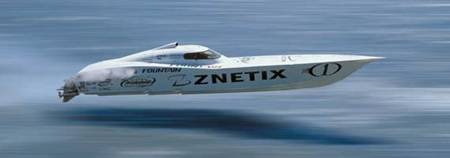Boat Types & Uses
One thing every boat has in common is a hull. A "hull", or bottom of a boat, comes in several different forms. Each form has a unique shape that give it certain handling and performance characteristics. Your boat has the hull form that it has to best match the type of boating it was designed for. In general, hull forms fall into one of the two following categories.
Planing Hulls

Planing hulls are designed to ride on top of the water, regardless of the weight of the boat. The flatter the bottom, the easier it is to get on plane. Also, less power is needed to attain high speeds with a flatter hull. The trade off is in handling. Flat hulls do not do well in rough water. Many planing boats use a shallow "V" shape to ride better in rough waters.
This Fountain 42 Lightning shows several design elements commonly found in modern boats-- a V-bottom for better handling in rough water that uses a "stepped" hull to give additional lift.
Displacement Hulls
Displacement hulls typically have a rounded bottom with a tear drop shape running bow to stern. Displacement hulls "displace" or move, an amount of water equal to the weight of the boat. Displacement hulls are very efficient-- most long range cruising boats such as trawlers and many sailboats use this type of hull. Because of their design, displacement hulls are restricted in their speed to the square root of their waterline length times 1.34. Therefore, a 64 foot boat can realistically only expect a top end speed of a little over 10 knots. The Grand Banks pictured here shows the design element typically found in displacement hulled vessels such as a rounded hull form and a bulbous bow. Grand Banks is a popular trawler.


